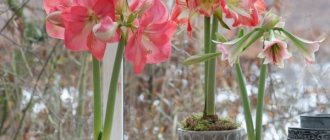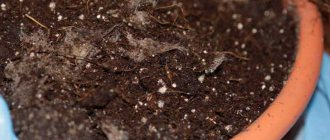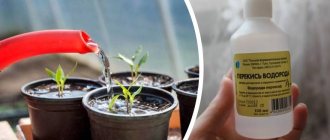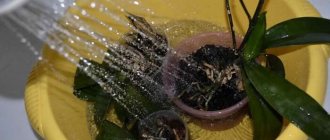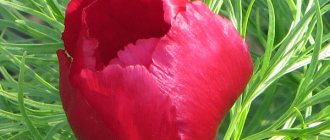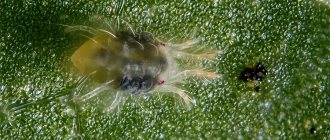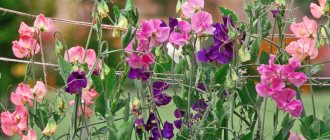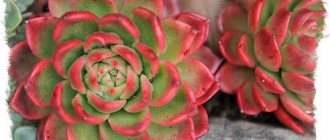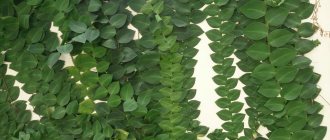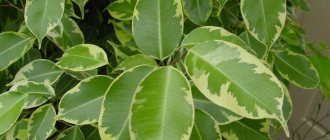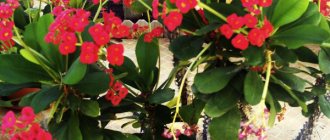Indoor plants not only decorate the interior of a room, but also bring significant benefits to humans. These green “healers” absorb a significant amount of harmful substances from the air and enrich it with oxygen, which has a positive effect on a person’s overall well-being. To protect home flowers from diseases and preserve their natural beauty, various fertilizers are used. Experienced gardeners recommend using iodine for indoor plants for additional feeding. This element promotes abundant flowering and more intensive development of vegetation.
Iodine for plants
In agricultural technology, root and foliar feeding with iodine is used.
Iodine deficiency
affects the growth and development of all plants. Iodine has a good effect on the yield, weight, color and taste of fruits. Promotes better absorption of nitrogen compounds.
Iodine is also used to boost the immunity of home flowers by pouring a solution of 3 drops of iodine per 3 liters of water. Water with this solution 3 times during the summer with the same interval between waterings.
The plants will be healthy, beautiful and blooming. Do not increase the proportion, this will lead to yellowing of the leaves and flowers - an excess of iodine.
How to prepare a solution for feeding with iodine
Fertilizing can be purchased at a specialized store. However, preparing an iodine-based solution for use as a fertilizer at home and taking into account the types of green spaces will not be difficult. The main thing in this matter is to adhere to two rules:
- exact adherence to the proportions of ingredients in the solution;
- proper watering or spraying of all plants (indoors and outdoors).
Iodine fertilizer prepared in the wrong proportion is poisonous and can kill the plant. Often this mixture negatively affects the growth of flowers and provokes the formation of yellow spots.
Particular attention should be paid to watering, where the mixture must be thoroughly mixed and introduced into the soil only along the walls of the pot. The fertilizer must penetrate the soil and in no case touch the root and foliage systems of plants.
Iodine use in the garden
Iodine is very useful for all garden crops. To increase the immunity of vegetable crops and prevent the appearance of pests and various diseases, 2 types of iodine solutions are used.
Solution No. 1
This solution should be applied before the formation of ovaries on the plants. Add 20 drops of iodine to 10 liters of water; this solution can be used once every 2 weeks.
Solution No. 2
This solution is used during the formation of ovaries. For 10 liters of water add 20 drops of iodine, 15 tbsp. l. hydrogen peroxide 3%, 1 liter of whey. Can be used once every 3 days.
Thanks to such solutions, the plants will be healthy, harmful microorganisms will die, and the plants will produce a good harvest.
Disinfection of seeds before planting
Iodine can be used to disinfect tomato seeds before planting instead of potassium permanganate or together with it. An iodine solution will help destroy harmful microorganisms located on the surface of the seeds. Thereby reducing the risk of developing diseases in already mature tomato plants.
To prepare a solution for disinfecting tomato seeds, you need to dissolve approximately 5 drops of 5% medical iodine in one liter of filtered water. The water should not be hot, but not cold either, and have a temperature of about + 25 °C.
- Tomato seeds are poured into the solution and left for 10 minutes.
- Then the iodine solution is drained, and the seeds are thoroughly washed in cool water.
- At the last stage, the seeds are dried on a sheet of napkin or paper.
Treating tomato seeds with an iodine solution can also help them sprout more quickly and smoothly.
Iodine for tomatoes
When growing vegetable seedlings before transplanting into the ground, water with a solution: 1 drop of iodine per 3 liters of water.
When watering tomato seedlings in this way, the flower clusters develop faster and are more branched, with more ovaries. The fruits are larger and ripen several days earlier.
After planting seedlings in the ground, it is recommended to water with a solution: 3 drops of iodine per 10 liters of water - 1 liter per plant.
Spraying technology and features
When foliar feeding tomatoes with iodine solution, standard sprayers are usually used. Each bush should be evenly moistened with the working solution. As a last resort, if you don’t have a sprayer, you can use an ordinary broom and bucket. A broom is moistened in a bucket and the iodine solution is shaken onto the bushes with tomatoes.
In the greenhouse
Since it doesn’t rain in a greenhouse, even when spraying, the entire nutrient iodine solution will be completely absorbed by the tomato leaves.
Therefore, the frequency of foliar feeding of tomatoes with iodine in a greenhouse can be halved. In addition, due to the lack of rain, the soil in the greenhouse is not thoroughly washed, and a higher concentration of active substances accumulates in it. This raises the risk of overdose.
Sometimes in greenhouses they use a different technology for feeding tomato bushes with iodine. To do this, vials with iodine are hung vertically on supports above the bushes, but without lids. The iodine evaporates and its vapors from the air are absorbed by the tomatoes. In this way, additional disinfection of the greenhouse premises also occurs.
In the open ground
It is better to spray in the morning or evening, when the plants are not in danger of being burned by sunlight on wet leaves. The jet pressure when spraying should not be too strong. It is especially effective to create an atmosphere of fog.
If it rains within 12 hours after the procedure, it is better to repeat foliar feeding. Because all the beneficial substances may not have time to be absorbed by the leaves and will be washed away.
Iodine for cabbage
When forming a head of cabbage, you need to prepare the following solution: 40 drops of iodine per 10 liters of water. Water the cabbage at the root - 1 liter of iodine solution per plant. To spray cabbage, mix 10 liters of water and 5 drops of iodine - prevent aphids and fight rot.
If young zucchini ovaries begin to rot, there is a lack of iodine in the soil. Dilute 10 drops of iodine into 10 liters of water and water the bushes.
Video - Iodine for the garden
For vegetable crops
In order for garden plants to grow and bear fruit well, and for vegetables to be tasty and healthy, seedlings also need to be periodically supported with iodine supplements.
Cabbage
Feeding is carried out for the purpose of:
- Soil disinfection. The solution is prepared from 2.5 ml of iodine and 10 liters of water. The area is processed before planting seedlings.
- Seed preparation: seeds are kept in an iodine solution for 2-3 hours.
- Prevention of infectious diseases. A mixture is made of 40 drops of iodine, 1 spoon of peroxide, a liter of whey and 40 liters of water. The beds are processed every 10 days.
Cabbage is fed during the formation of the first leaves and during the setting of a head of cabbage. If signs of vegetable damage by aphids or gray mold appear, it is advisable to foliarly spray the seedlings with an iodine solution (five drops).
cucumbers
To fertilize the vegetable crop in question, it is recommended to use regular iodine fertilizer. You can add milk to the composition: 30 drops of the pharmaceutical preparation are dissolved in 1 liter of natural product. Fertilizing is applied once every fourteen days.
Young plants are treated against root rot 3-4 times, lubricating diseased stems with iodine solution.
Tomatoes and eggplants
The first fertilizing of crops with microelements is carried out during the bud formation phase. To do this, dissolve 20 drops of iodine and 500 ml of whey in 5 liters of water. Plants are sprayed with the solution until completely wet.
The second and third feeding is carried out in the middle of the flowering phase and during fruiting. Add ½ tsp to the nutrient solution described above. boric acid, having previously dissolved it in hot water. Boron enhances flowering and prevents the ovaries of plants from falling off.
bell pepper
First, the seeds are treated (a drop of alcohol tincture in a cup of water). When the first leaves appear on the seedlings, the soil is treated with a solution based on a mixture of a drop of iodine in three liters of settled water.
The next feeding is carried out when the pepper has taken root well in the open ground. The “medicine” is made using three drops of tincture in a bucket of water. One liter of solution is required for one pepper. After feeding, the pepper quickly sets fruit, does not get sick and produces a good harvest. To protect against late blight, I spray the leaves and stems.
Grape
This crop may suffer from fungal diseases. To spray grapes, make a medicinal product based on milk (liter) and iodine (20-22 drops). The leaves are thoroughly sprayed with this mixture. The procedure is carried out three times a month. If the plant is sick, the time period is increased.
For strawberries
In order to prevent diseases and increase productivity in the spring, strawberry beds are treated with medicinal compounds that include iodine. The most commonly used solution is 10 drops of iodine in 10 liters of water. Processing strawberries requires care. When spraying plants, they try to prevent the composition from getting on the central bud, which is located on the surface of the soil. The same solution can be used to spill the soil around the roots of plants.
Iodine use against diseases
Powdery mildew on cucumbers
Powdery mildew that appears on cucumbers can lead to plant death. To avoid this, it is necessary to treat the cucumbers with a solution containing iodine. Add 1 drop of iodine to 1 liter of milk. We spray cucumber leaves with this solution once every 7 days.
For the prevention of late blight
and to get rid of crown rot, use a solution: 10 ml of iodine per 10 liters of water. Spray tomatoes, peppers, and eggplants.
Microelement properties
The substance is widely used in vegetable growing and horticulture as a fertilizer. It promotes the production of useful amino acids, ensures normal metabolism within the plant organism, and is responsible for the process of cellular respiration.
Iodine is useful for plants because it:
- fights infections and parasites;
- strengthens the immunity of seedlings;
- disinfects the soil;
- saturates plant cells with vitamin C;
- participates in nitrogen synthesis;
- eliminates pathogenic microorganisms.
Among the main advantages of iodine-based fertilizer are accessibility and effectiveness.
This type of fertilizer can be purchased at any pharmacy. The product is safe and does not have any negative effects.
Scientific facts about fertilizer
In open ground, iodine comes from precipitation, so crops growing outside receive this substance naturally, at least in small quantities. At home, you need to saturate the soil yourself. Scientific experiments were carried out, during which it turned out that with proper feeding, all indoor flowers reacted positively: the plants recovered faster from illnesses, the buds became more lush and beautiful, and the color of the leaves was brighter.
There is no exact explanation why iodine as a supplement gives such excellent results. Scientists have suggested that this element regulates the functioning of enzyme systems, thus improving metabolism in plants. But no matter how much controversy there is around feeding with this element, the fact is obvious: the benefits of this substance are enormous.
Iodine is able to “reanimate” plants even in the most hopeless cases. Research was carried out on indoor flowers infected with diseases. Here are some examples:
- The use of iodine as a fertilizer literally “extended the life” of anthurium. The plant had already lost all its leaves, but after several waterings with the solution, recovery occurred. After just a couple of months, the anthurium became a healthy, beautiful flower with lush green leaves.
- Red raised spots appeared on the leaves of gladiolus and snapdragon. The fungus has already spread throughout the entire stem. The use of iodine saved the flowers from death; not a trace of “rust” remained.
- An experiment was conducted with chrysanthemums affected by nematodes. Feeding flowers helped get rid of harmful parasites.
Iodine also has a positive effect on garden crops as a fertilizer. There was a significant increase in the number of fruits, as well as an improvement in their taste.
How to determine iodine deficiency in plants?
Iodine deficiency is difficult to detect visually. The lack of a substance in plant cells is indicated by:
- decreased fruiting of seedlings;
- blanching, yellowing of leaf blades;
- weakening of stems;
- reduction in fruit size, change in color.
If plants lack iodine, they often get sick, are more susceptible to infections and pests, their root system suffers: it freezes, develops little, its ability to absorb nutrients from the soil decreases, and the speed of their transfer to the trunk and leaves slows down.
Is iodine safe for plants?
Iodine is used as a fertilizer for plants. So far, the mechanism of iodine absorption by various representatives of the flora has been little studied. It is well established that seaweed accumulates iodine because the element dissolved in water is absorbed very well by plants. Iodine contained in the soil in organic form is practically not absorbed by plants.
It becomes available to the root system after organic residues are decomposed by soil bacteria, and iodine remains in the soil. The concentration of iodine in plant sap will depend on the type and nature of the soil. Moreover, there is more iodine in the above-ground parts of plants than in the roots. This is due to the fact that iodine is absorbed by leaf plates from the atmosphere.
It has been established that the level of iodine in 1 kg of nutrient solution in the amount of 0.1 mg can already have a stimulating effect on the ability of some plants to vegetate and reproduce. At the same time, studies were carried out on tomatoes and buckwheat, which showed that the plants did not react in any way to the application of 1.1 kg of iodine per 1 hectare of plantings. But a dose of 11 kg per 1 ha turned out to be toxic.
This is interesting: How to properly prune Geranium at home so that it is fluffy
Iodine application against pests
Pests such as weevils and chafer larvae are afraid of treatment with iodine solution.
As a preventive measure against cockchafer larvae
prepare a solution: 20 ml of iodine per 10 liters of water, water 1 liter for each bush (when watering, for example, strawberries, perennial flowers).
If the larvae harm young currant bushes, pour 5 liters of the same solution per bush. Water with this solution 2 times a season in spring and autumn (August).
If you see that the plant is dying or withering, water it 3 times with an interval of 5 days with iodine solution: 20 ml per 10 liters of water. Water in the evening, trying not to get it on the leaves.
Prevention against the appearance of weevils
– treatment of a strawberry plot in early spring (when the soil is still covered with snow) with a solution of 1 tsp. iodine per 10 liters of water.
Video - Using iodine in the fight against cockchafer larva
Features of use in greenhouses and open ground for vegetables
You can purchase iodine either medically, then dilute it according to the recipe, or in the form of a special development - Farmayod Disinfectant.
The proposal for gardeners involves the use of a product to disinfect equipment, soil, and plants, as it has a fungicidal, antiviral and bactericidal effect.
The disinfectant also needs to be diluted, despite the fact that the concentrate is a 10% solution. To obtain a working solution, the ratio is: 1 liter of water + 10 ml of concentrate.
Farmayod cannot be used for home recipes. They take exclusively medical, where the concentration is 5%. The standard working fluid is made at the rate of adding 1-2 drops of iodine per 1 liter.
To prepare the soil in greenhouses and open areas, after choosing a solution, water the soil. After 2-5 days, seedlings can be planted.
If it is necessary to disinfect the greenhouse, choose a standard mixture. Wet a natural fabric and wipe the surface from the inside. Wooden, glass and metal elements are subject to processing.
Important! All garden tools must be disinfected regularly. Especially if plants are pruned. This includes not only pruning shears, but also saws, shovels, and knives. Before starting work, they are wiped with iodine or manganese solution. Therefore, it is recommended to stock up on liquid in advance.
Iodine for strawberries
Strawberries are treated with an iodine solution after flowering to combat weevils and May beetle larvae, and the appearance of rot on plants.
Prepare the solution
10 ml of iodine per 10 liters of water, for sticking add 2 tbsp. l. liquid soap. Stir and spray the bushes and berries, and also water under the plants.
As a preventive measure, you can water the plot of land where strawberries grow in early spring with the same solution.
To get rid of aphids on the leaves of bushes and trees, use the following solution: 1 ml of iodine per 1 liter of milk, spray once every 10 days.
Beneficial properties of iodine as a fertilizer
Practice and scientific experiments have shown that with the correct use of iodine supplements, the following effect is achieved:
- metabolism improves due to the regulation of the enzyme systems of green spaces;
- resuscitation of plants even in hopeless cases;
- the life of flowers is extended;
- recovery from illness occurs in the shortest possible time.
With proper application of fertilizer, the color of the leaves becomes brighter, the flowering of the buds becomes more magnificent, and intensive development of the home green space is observed.
It is recommended to use iodine as a plant supplement for preventive purposes, as this liquid has antifungal and antiseptic properties. In addition, this application will protect indoor green spaces from various diseases.
